Comments
provided by eFloras
Yucca reverchonii is endemic to the Edwards Plateau. J. M. Webber (1953) reported apparent hybrids of this species with Y. rupicola and Y. thompsoniana. S. D. McKelvey (1938–1947) indicated that Y. reverchonii occupies an area of the Plateau between those of Y. rupicola and Y. thompsoniana. K. H. Clary (1997) presented DNA evidence that confirms a close relationship among these three species as distinct entities.
- license
- cc-by-nc-sa-3.0
- copyright
- Missouri Botanical Garden, 4344 Shaw Boulevard, St. Louis, MO, 63110 USA
Description
provided by eFloras
Plants solitary or forming dense, open colonies of rosettes, acaulescent, with branching subterranean caudices; rosettes 2–10 per colony, each rosette with fewer than 100 leaves. Leaf blade lanceolate, straight, slightly concave, nearly flattened, widest at middle, 25–60 × 1–2(–2.5) cm, rigid, slightly glaucous, margins denticulate, yellow or reddish brown, hyaline. Inflorescences narrowly paniculate, arising beyond rosettes, narrowly ovoid, 3.5–10 dm, densely pubescent; bracts erect; peduncle sometimes scapelike, 0.5–1.1 m, less than 2.5 cm diam. Flowers pendent; perianth campanulate; tepals distinct, white or greenish white, ovate, 4–6 × 1.5–3 cm, apex sharply acuminate; filaments 1.8–3.2 cm; pistil 3–4.5 cm × 4–6 mm; style white or greenish, 10–20 mm; stigmas lobed. Fruits erect, capsular, dehiscent, ellipsoid, 4–6 × 1.8–3.2 cm, dehiscence septicidal. Seeds dull black, thin, 5–7 mm diam.
- license
- cc-by-nc-sa-3.0
- copyright
- Missouri Botanical Garden, 4344 Shaw Boulevard, St. Louis, MO, 63110 USA
Habitat
provided by eFloras
Rocky hillsides, limestone ledges, gravelly plains with dense brush; 400--900m.
- license
- cc-by-nc-sa-3.0
- copyright
- Missouri Botanical Garden, 4344 Shaw Boulevard, St. Louis, MO, 63110 USA
Yucca reverchonii: Brief Summary
provided by wikipedia EN
Yucca reverchonii is a plant in the family Asparagaceae. It is native to the Edwards Plateau region of Texas, as well as to the Mexican states of Tamaulipas, Nuevo León, Coahuila, Chihuahua, Durango, Zacatecas, Aguascalientes, and San Luís Potosí. It is known as the San Angelo yucca and is closely related to Y. rupicola Scheele and Y. thompsoniana Trel.
Characters that distinguish this species include:
Low, trunkless growth form, forming scattered colonies on limestone. Leaves lack curling "hairs" on edges, and are very finely toothed. Leaves nearly flat, straight (little or no twist), and usually less than 15 mm wide.
- license
- cc-by-sa-3.0
- copyright
- Wikipedia authors and editors

